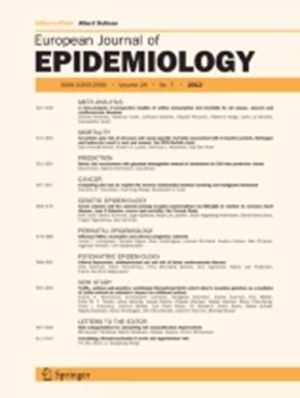Particulate matter exposure during pregnancy and birth outcomes: exposure windows of susceptibility and socioeconomic inequalities.
IF 5.9
1区 医学
Q1 PUBLIC, ENVIRONMENTAL & OCCUPATIONAL HEALTH
引用次数: 0
Abstract
We aimed (i) to assess the relationship of pregnancy-average particulate matter (PM) exposure with birthweight, birthweight at term, low birthweight at term, small for gestational age, and preterm birth, (ii) to identify critical windows of susceptibility to PM exposure across pregnancy on birthweight and small for gestational age, and (iii) to assess the presence of socioeconomic inequalities on these associations. We established a population-based, nationwide cohort using the Spanish birth registry between 2004 and 2016 (N = 3,678,445). We estimated daily PM10 and PM2.5 concentrations for the entire pregnancy at the maternal residential address at child's delivery using spatiotemporal land use random-forest models. Linear, logistic, and distributed lag linear models were used for the different analysis. All models were stratified by maternal educational level and area-level deprivation index. Mean PM10 and PM2.5 concentrations during pregnancy were 25.1 and 12.7 µg/m3, respectively. Higher pregnancy-average PM10 concentrations were associated with lower birthweight and increased odds of preterm birth (-7.1 g [95%CI -8.5; -5.7] and OR 1.04 [95%CI 1.02; 1.05], respectively, per 10 µg/m3 increase in PM10). Similar results were found for PM2.5, in particular for levels above 10 µg/m3. These associations were stronger in infants born to mothers with lower education, particularly when combined with residence in more deprived areas. We observed some windows of susceptibility to PM10 for birthweight, mainly in the third trimester of pregnancy, with a similar pattern across socioeconomic levels. We did not observe windows of susceptibility to PM2.5. Structural policies to reduce exposure to current PM levels in pregnant women and socioeconomic inequalities are needed.怀孕期间的颗粒物暴露和分娩结果:易感性的暴露窗口和社会经济不平等。
我们的目的是(1)评估妊娠期平均颗粒物(PM)暴露与出生体重、足月出生体重、足月低出生体重、小胎龄和早产之间的关系,(2)确定整个妊娠期出生体重和小胎龄对PM暴露易感的关键窗口,以及(3)评估这些关联中存在的社会经济不平等。我们利用2004年至2016年西班牙出生登记处建立了一个以人口为基础的全国性队列(N = 3,678,445)。我们使用时空土地利用随机森林模型估计了母亲居住地址在孩子出生时整个怀孕期间的每日PM10和PM2.5浓度。采用线性、logistic和分布滞后线性模型进行不同的分析。所有模型均采用母亲受教育程度和地区剥夺指数进行分层。怀孕期间PM10和PM2.5的平均浓度分别为25.1和12.7µg/m3。较高的妊娠期平均PM10浓度与较低的出生体重和早产几率增加相关(-7.1 g [95%CI -8.5;-5.7] OR 1.04 [95%CI 1.02;[1.05], PM10每增加10µg/m3)。PM2.5也出现了类似的结果,特别是当PM2.5浓度超过10微克/立方米时。这些关联在受教育程度较低的母亲所生的婴儿中更为明显,特别是当母亲居住在更贫困的地区时。我们观察到一些PM10对出生体重的易感性窗口,主要是在怀孕的第三个月,在社会经济水平上具有相似的模式。我们没有观察到PM2.5敏感性窗口。需要采取结构性政策,以减少孕妇暴露于目前的PM水平和社会经济不平等。
本文章由计算机程序翻译,如有差异,请以英文原文为准。
求助全文
约1分钟内获得全文
求助全文
来源期刊

European Journal of Epidemiology
医学-公共卫生、环境卫生与职业卫生
CiteScore
21.40
自引率
1.50%
发文量
109
审稿时长
6-12 weeks
期刊介绍:
The European Journal of Epidemiology, established in 1985, is a peer-reviewed publication that provides a platform for discussions on epidemiology in its broadest sense. It covers various aspects of epidemiologic research and statistical methods. The journal facilitates communication between researchers, educators, and practitioners in epidemiology, including those in clinical and community medicine. Contributions from diverse fields such as public health, preventive medicine, clinical medicine, health economics, and computational biology and data science, in relation to health and disease, are encouraged. While accepting submissions from all over the world, the journal particularly emphasizes European topics relevant to epidemiology. The published articles consist of empirical research findings, developments in methodology, and opinion pieces.
 求助内容:
求助内容: 应助结果提醒方式:
应助结果提醒方式:


